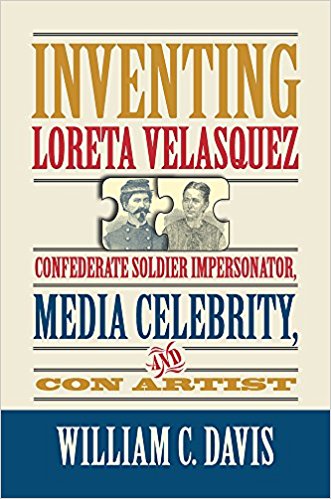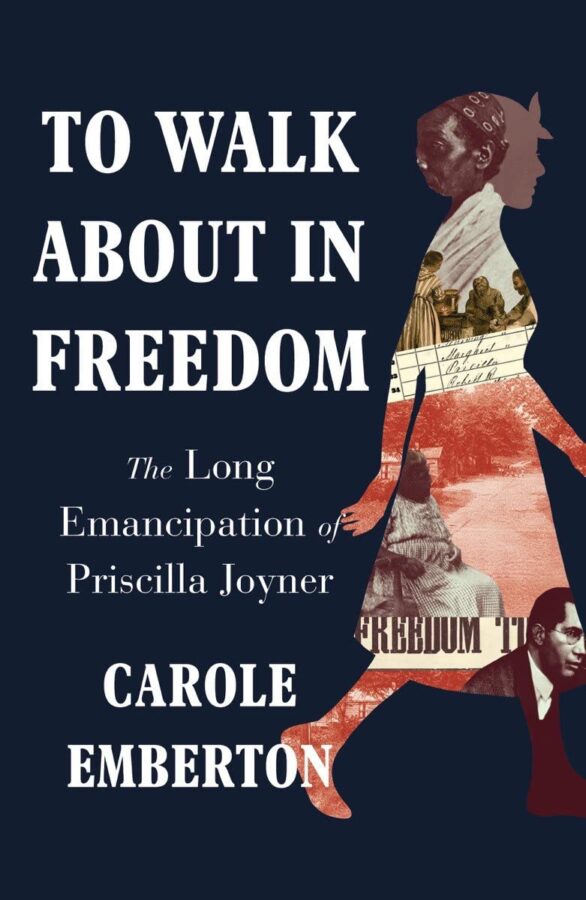Inventing Loretta Velasquez: Confederate Soldier Impersonator, Media Celebrity, and Con Artist by William C. Davis. Southern Illinois University Press, 2016. Cloth, ISBN: 978-0809335220. $39.95.
 Loreta Velasquez allegedly posed as Lieutenant Harry T. Buford and fought for the rebels during the American Civil War. Her story, regardless of its veracity, has fascinated people for years. Some scholars, as author William C. Davis notes, “have chosen to ignore the question of authenticity because her memoir is so rare, so dramatic, and so suitable to illustrate a variety of themes from women warriors to gender inequity in America” (1). Davis’s initial goal was to find the truth in Loreta’s story. But along the way, the search for truth became a quest to discover the woman behind the myth. In so doing, Davis unearthed the “unknown life that she led for nearly six decades after the war, a genuine story as dramatic as any of her fables” (2).
Loreta Velasquez allegedly posed as Lieutenant Harry T. Buford and fought for the rebels during the American Civil War. Her story, regardless of its veracity, has fascinated people for years. Some scholars, as author William C. Davis notes, “have chosen to ignore the question of authenticity because her memoir is so rare, so dramatic, and so suitable to illustrate a variety of themes from women warriors to gender inequity in America” (1). Davis’s initial goal was to find the truth in Loreta’s story. But along the way, the search for truth became a quest to discover the woman behind the myth. In so doing, Davis unearthed the “unknown life that she led for nearly six decades after the war, a genuine story as dramatic as any of her fables” (2).
Loreta Velasquez was a woman of mystery and secrecy. At various times in her life, she went by Loreta, Ann, Laura, and Lauratita. According to Davis, her name was Lauretta, the name he uses throughout the book. Because there is not much information about her early life, the book quickly moves to the Civil War itself. At the beginning of the conflict, Lauretta dressed up as a male soldier to gain notoriety. She did not actually want to fight and designed her disguise to generate attention and press coverage. As “Lieutenant Harry T. Buford,” an instant media celebrity, she met rebel officials such as the Confederate War Department clerk John B. Jones. Despite suspicions, Jones signed a passport for her. She later spent a few days in jail while authorities investigated her story, although they determined she was harmless and released her. From this early episode, Lauretta learned “she could pull off a big bluff and get away with it” (20).
Although quite a cagey operator, her decisions were not always particularly wise. In 1862, she returned to New Orleans, persuaded Unionists to give her money for transportation, lodged with a Unionist family, and stole jewelry from them. She fled, but was apprehended, tried for larceny, and sentenced to a term in the parish prison. Amazingly, Lauretta convinced her captors she was ill and got herself transferred to the Charity Hospital. She even persuaded a doctor to give her a pass to walk around the city. Rather than flee, she returned to her old haunts. The same policeman who tracked her down before apprehended her again. This episode, although seemingly trivial, was an important window into her character. She was both talented enough to pull off a convoluted plan, and foolhardy enough to stay in town. She erased this episode in her account by claiming that she ran afoul of Benjamin F. Butler, who had her imprisoned.
In addition to being overconfident, Lauretta played fast and loose with the truth. “Every time she told her story,” Davis notes, “it changed” (35). Some changes made sense. Others were nonsensical. Lauretta often lied about facts that could be easily confirmed, such as claiming that she survived the 1866 explosion of the steamboat Miami. Whether she had a constant desire to embroider, was a pathological liar, or simply could not keep her increasingly complicated fictions straight is uncertain. However, consistency in storytelling was not her strong suit.
Lieutenant Harry T. Buford was one of Lauretta’s many cons. Even as she developed the story of the female lieutenant, she placed advertisements in newspapers about her “family” in the Caribbean, suggesting she would soon come into an inheritance. With these articles, she could ensnare other people in her scams. In doing this, she “anticipated ruses that criminal confidence would would be practicing in years to come” (92).
After the Civil War ended, one might think she would retire the good lieutenant; nonetheless, she kept Buford alive and claimed she wanted to write a history of the war. For a time, Lauretta went west. She even married a prosperous miner, Edward Hardy Bonner. People later claimed that she bled him dry and left him to return east. Indeed, Lauretta’s ability to hoodwink and manipulate was nothing short of astounding. Case in point: for decades, she used James Longstreet as a reference, despite having never met him!
Although she retired Harry T. Buford when she married Bonner, Lauretta dusted him off in the mid-1870s. She tried to talk Mark Twain into collaborating with her on a book, but Twain refused. This did not stop her from claiming Twain as her co-author, a rumor he publicly denied. As she prepared to publish the book, Lauretta adopted the persona everyone knows: L. J. Velasquez of Cuba. This was the first time she claimed to be Cuban. Readers will appreciate Davis’s deconstruction of her book, The Woman in Battle. Most of the book was “an exercise in the bizarre” (153), and errors were legion. In addition, rather remarkably, Lauretta “cavalierly contradicted almost everything she had said about her life from her first appearance in print as Mary Ann Keith almost fifteen years earlier” (170).
Rather than settling down after publishing the book, she continued to play confidence games. Lauretta conned people out of money by claiming she would increase European immigration to the South. She also promoted a railroad that she had no intention of building. In the early 1900s, her cons stopped due to the rapid transmission of news. She spent the last decade of her life in Washington’s Government Hospital for the Insane and, in the end, “the women who lived a fictionalized life largely of her own creation in the newspapers died without a single mention or obituary in the press” (237).
The final chapter, “Legends, Legacy, and Legerdemain,” provides excellent (if occasionally pungent) analysis of how scholars have dealt with Lauretta. Davis notes that her book became “ideal for postmodernists, poststructuralists, and other related theorists” because it provided “a neutral mannequin on which scholars could drape any raiment they chose, unbothered about the conflicts and falsehoods in her story” (244). Although he does not completely toss aside the analyses of postmodern and poststructuralist professors of English and American literature, he offers sharp criticisms.
There is always a danger with a biography that the author will fall in love with his or her subject. Clearly, such is not the case here. Davis has no problem showcasing Lauretta’s many flaws. At the same time, he does not overlook some of her better qualities, such as her denunciation of Georgia’s convict labor system. His treatment is, on the whole, scrupulously fair. In sum, this is a fascinating book that strips away much of the myth and legend from the life of an enigmatic woman; it offers readers a more accurate, complex portrayal of Velasquez’s life. Davis’s book is well suited for popular and academic audiences.
Evan C. Rothera is finishing his dissertation in the Department of History at The Pennsylvania State University.
